January 2026

The telehealth and telemedicine market is anticipated to grow from USD 286.22 billion in 2025 to USD 1209.26 billion by 2035, with a compound annual growth rate (CAGR) of 15.5% during the forecast period from 2026 to 2035.
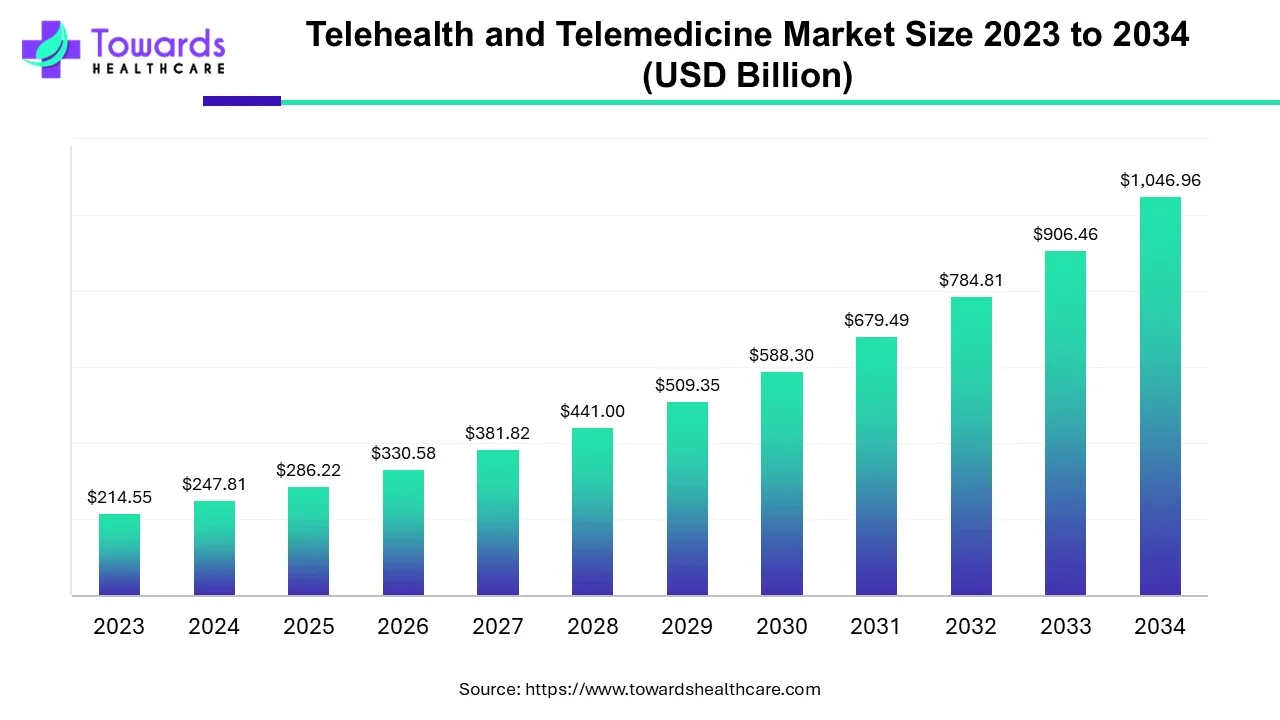
| Key Elements | Scope |
| Market Size in 2026 | USD 330.58 Billion |
| Projected Market Size in 2035 | USD 1209.26 Billion |
| CAGR (2026 - 2035) | 15.5% |
| Leading Region | North America |
| Market Segmentation | By Component, By Delivery Model, By Technology, By Application, By Geography |
| Top Key Players | AT&T, Philips Healthcare, GE Healthcare, Medtronic, Teladoc Health, Amwell, Zoom Video Communications, MDLIVE, doxy.me, VSee |
"Understanding the growing demand for telemedicine, innovations in telehealth are on the rise, spurred by the significant uptake observed, as reported by the CDC, where 37.0% of adults have utilized telemedicine in 2021."
Telehealth and telemedicine are about using technology for healthcare from a distance. While they're similar, telehealth covers a broader range, including remote monitoring and education, while telemedicine focuses on clinical services like diagnosing and treating patients remotely.
The market for telehealth and telemedicine has grown a lot recently. Technology has improved, making it easier to connect remotely using the internet, smartphones, and wearable devices. People also want more remote care because of things like aging populations and chronic diseases, especially in areas where it's hard to get to a doctor's office. Plus, it's often cheaper than going in person, which is excellent for routine check-ups or managing ongoing health issues. The COVID-19 pandemic has pushed this even more. With the need to stay safe and avoid crowded places, healthcare providers turned to telehealth to keep treating patients.
The World Health Organization (WHO) forecasts a 10 million healthcare workers shortage by 2030. This need for healthcare professionals is expected to drive using artificial intelligence (AI) for treating and diagnosing patients. Telehealth provides healthcare services digitally and virtually to patients in distant areas.
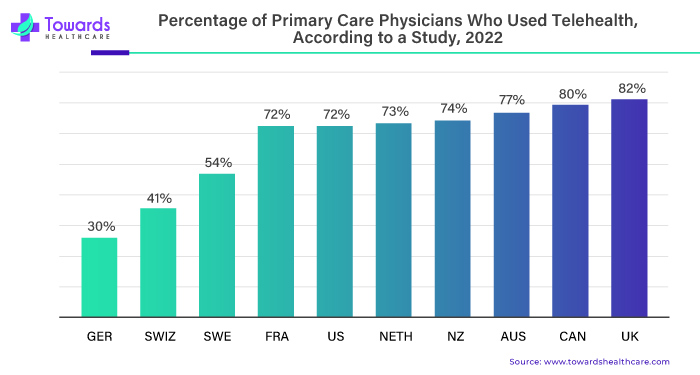
Governments and regulators have also stepped in to support telehealth, making sure things like insurance cover it and that patient data stays safe. Many people, like doctors, tech companies, insurance companies, and patients, are involved in telehealth. There are platforms and software to help with virtual visits and monitoring patients, as well as devices like wearables that can track things like heart rate or blood sugar levels remotely.
The telehealth and telemedicine market is set to keep growing. As technology improves and rules more precise, more people will turn to these convenient and accessible ways to get healthcare. But there are still challenges, like ensuring everyone can access these services and securing patient information.
In addition, AR and VR in healthcare act as powerful allies to telehealth and telemedicine, enabling more immersive, interactive, and effective remote healthcare experiences. As these technologies continue to evolve, we can expect an even stronger synergy, ultimately transforming the future of healthcare delivery. Furthermore, the integration of health and wellness with telehealth and telemedicine, powered by technology like AR/VR, paves the way for a future where personalized, accessible, and engaging healthcare experiences are available to everyone.
Artificial Intelligence and it's models play a transformative role in telemedicine and telehealth by enhancing the efficiency, accuracy, and accessibility of healthcare services. Through AI-powered tools such as chatbots, virtual assistants, and diagnostic algorithms, patients can receive preliminary assessments, schedule appointments, and access medical advice without visiting a clinic. AI also enables remote monitoring of patients using wearable devices, which collect and analyze health data in real-time, allowing for early detection of potential issues.
Moreover, AI aids healthcare professionals by supporting clinical decision-making, automating administrative tasks, and providing predictive analytics, ultimately improving patient outcomes and reducing the burden on medical infrastructure. Considering instances, 1. Apps like Babylon Health use AI to assess symptoms reported by patients and provide possible diagnoses or recommend further action, such as connecting with a doctor through teleconsultation. 2.Livongo and Current Health use AI to track chronic conditions such as diabetes or heart disease by analyzing data from wearables and sensors, alerting doctors if there are concerning changes.
The global AI in telehealth and telemedicine market is valued at USD 3.89 billion in 2024 and is expected to rise to USD 5.3 billion in 2025, projected to reach approximately USD 86.31 billion by 2034, advancing at a CAGR of 36.35% from 2025 to 2034.

Telemedicine is making a significant impact on healthcare delivery in several ways:
Overall, these findings suggest that telemedicine is transforming healthcare by making it more accessible, efficient, and cost-effective while improving the quality of care and strengthening relationships between patients and their doctors.
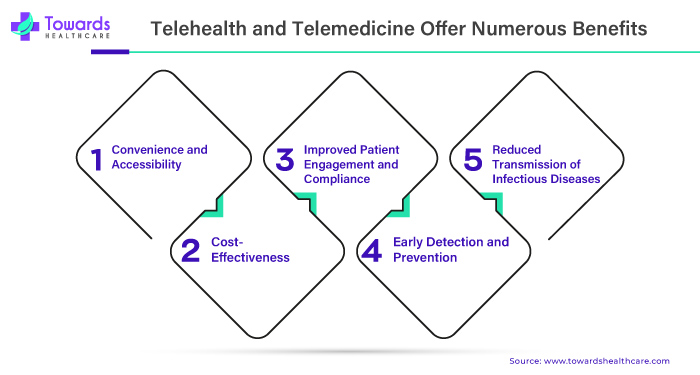
Wearable devices, such as smartwatches or fitness trackers, are another essential part of telehealth. They can monitor vital signs like heart rate and activity levels in real-time, providing valuable insights into a person's health. For example, they can help manage chronic conditions by tracking symptoms and reminding patients to take their medications. Wearables empower patients to take control of their health by giving them personalized feedback and encouraging healthy lifestyle choices. Plus, when integrated with telemedicine platforms, these devices allow patients to share their health data with their healthcare providers during virtual appointments, helping doctors make more informed decisions about their care.
Wearable Gadgets
| Sr. No. | Indication | Launched Date | Device Details |
| 1. | General Health and Fitness |
January 2024 October 2023 |
|
| 2. | Chronic Condition Management |
October 2023 September 2023 |
|
| 3. | Mental Health and Wellbeing |
November 2023 November 2023 |
|
Advances in remote monitoring devices have revolutionized how patients manage their health and transform the healthcare landscape by extending the reach of telehealth beyond traditional clinical settings. By empowering patients to take an active role in monitoring their health at home and transmitting data to healthcare providers remotely, these devices have shifted the focus of healthcare from reactive to proactive management.
This proactive approach to healthcare is characterized by continuous monitoring and early intervention. It enables healthcare providers to detect subtle changes in patient's health parameters before they escalate into serious medical issues. For patients with chronic conditions such as hypertension, diabetes, or heart disease, remote monitoring devices offer a lifeline, providing reassurance and support in managing their conditions on a day-to-day basis.
Additionally, the seamless integration of remote monitoring data into telehealth platforms enhances care coordination and decision-making, enabling healthcare providers to deliver personalized, evidence-based interventions customized to each patient's needs. By leveraging real-time health data, healthcare teams can prioritize resources, optimize treatment plans, and intervene promptly when necessary, ultimately improving patient outcomes and quality of life.
Innovation drives market growth in telehealth and telemedicine by continuously expanding the scope of services, improving the user experience, and enhancing the efficacy of remote healthcare delivery. From AI-powered virtual assistants and remote diagnostic tools to virtual reality-based therapy and remote surgical interventions, ongoing advancements in technology and healthcare innovation are reshaping the future of telehealth.
For instance,
The convergence of remote monitoring devices and healthcare innovation is driving the expansion of telehealth and telemedicine, empowering patients, improving outcomes, and revolutionizing the delivery of healthcare services worldwide. As technology continues to evolve and new opportunities emerge, telehealth will play an increasingly central role in the future of healthcare, offering accessible, convenient, and practical solutions to meet the diverse needs of patients and providers alike.
Limited digital literacy among specific patient populations, especially older adults and individuals with lower socioeconomic status, presents a significant obstacle to effectively utilizing telehealth services. Digital literacy encompasses accessing, understanding, and effectively using digital technologies for navigating online platforms, communicating digitally, and accessing information and services. Several factors contribute to the challenges faced by these populations when engaging with telehealth platforms.
Older adults and those of lower socioeconomic status often lack access to reliable internet connectivity and digital devices like smartphones, tablets, or computers. These essential tools are necessary for them to participate in telehealth consultations or access digital health resources. Moreover, many individuals in these demographics need more familiarity with digital technologies and may feel intimidated or overwhelmed by telehealth platforms, deterring them from seeking such services.
Additionally, language and cultural barriers further complicate the use of telehealth platforms for specific populations. Individuals who primarily speak languages other than English may struggle to navigate platforms that are not available in their native language, leading to frustration and misunderstanding. Furthermore, health literacy is crucial in effective engagement with telehealth services. Individuals with limited health literacy may need help comprehending medical terminology, following complex instructions, or adhering to treatment plans recommended during telehealth consultations.
Targeted strategies are essential to address these challenges and ensure equitable access to telehealth services. These include offering digital literacy training programs explicitly personalized to older adults and individuals with lower socioeconomic status, empowering them with the necessary skills and confidence to navigate telehealth platforms effectively. Designing telehealth platforms with user-friendly interfaces, clear instructions, and intuitive navigation can also help lower the barrier to entry for individuals with limited digital literacy. Providing multilingual support and culturally sensitive resources can improve accessibility for diverse populations.
Which Component Segment Dominated the Telehealth and Telemedicine Market?
The software & services segment held a dominant position in the market in 2025, due to the availability of user-friendly software and high affordability. Software & services eliminate the need for healthcare professionals to build a specialized healthcare infrastructure for their installation, reducing upfront costs. Services do not demand an annual subscription to software or managing hardware components. Software & services enable patients and providers to access confidential data from anywhere and at any time.
How the Cloud Segment Dominated the Telehealth and Telemedicine Market?
The cloud segment held the largest revenue share of the market in 2025, due to the need for storing huge amounts of patient data. Cloud-based tools offer high scalability, remote data access, and reduced overhead costs. They can be accessed on mobile devices or other devices by patients and healthcare professionals. Numerous rural areas are developing an advanced cloud infrastructure to support the digitization in healthcare organizations. Healthcare organizations can back up data regularly and pay only for the resources they use.
Telemedicine Platforms Simplify Administrative Duties and Link Patients with Specialists Who May Be Distant
In 2023, HealthTap (US) introduced a new service called "HealthTap Circle," which operates on a subscription basis and provides personalized health coaching and access to support groups. Telemedicine platforms, like online doctor's offices, allow patients to have appointments with healthcare providers without needing to visit a physical clinic. These platforms streamline administrative tasks and connect patients with specialists who might be far away, improving access to specialized care for conditions like heart problems or mental health issues. They also engage patients more by offering tools like medication reminders and educational resources while ensuring that personal health information stays private and secure.
For instance,
In November 2023, Qure.ai used AI technology for diagnostics and helped patients connect with specialists in different fields.
Why Did the Chronic Disease Management Segment Dominate the Telehealth and Telemedicine Market?
The chronic disease management segment contributed the biggest revenue share of the market in 2025, due to the rising prevalence of chronic disorders and the growing awareness of telemedicine platforms. In the U.S., about 3 in 4 American adults have at least 1 chronic disease. Telemedicine allows patients to seek personalized care from physicians across diverse geographical locations, without physically visiting them. The increasing use of wearable devices enables providers to monitor patients in real time.
North America, particularly the United States and Canada, leads the global telehealth market in terms of market share and adoption. Factors driving growth in this region include:
Additionally, the COVID-19 pandemic has accelerated the adoption of telehealth in North America, leading to increased investment in digital health solutions and greater acceptance of remote care delivery.
U.S. Market Trends
Approximately 79% of the U.S. hospitals offer virtual telehealth services, and 80% of consumers have used telemedicine in 2024. The Centers for Medicare and Medicaid Services also supports telehealth services for non-behavioral/mental healthcare.
Canada Market Trends
According to the Canadian Institute for Health Information (CIHI), about 1 in 4 primary care physicians (27%) use remote monitoring or connected medical devices to monitor patients with chronic conditions.
Europe is experiencing rapid growth in the telehealth market, driven by factors such as aging populations, rising healthcare costs, and increasing demand for chronic disease management. Countries like the United Kingdom, Germany, and France are at the forefront of telehealth adoption, with initiatives to expand access to remote healthcare services and integrate telemedicine into existing healthcare systems.
UK Market Trends
The COVID-19 pandemic potentiated the demand for telemedicine across the UK. It is estimated that about 1.7 million people in the UK benefit from telecare services. Telehealth & telemedicine services comply with the NHS' aim of providing universal healthcare. Also, telemedicine significantly reduces healthcare disparities in rural areas.
The Asia-Pacific region is poised for significant growth in the telehealth market, driven by increasing smartphone penetration, expanding internet connectivity, rising healthcare expenditures, and a growing need for remote healthcare services in rural and underserved areas. Countries like China, India, Japan, and South Korea are investing in telehealth infrastructure and digital health initiatives to address healthcare access barriers and improve population health outcomes.
Japan Market Trends
The Japanese government’s Ministry of Health, Labor, & Welfare actively promotes telemedicine to address the shortage of doctors and uneven distribution of healthcare resources. The “Guideline Concerning Proper Implementation of Telemedicine” was issued to guide the permissible scope of telemedicine in Japan.
India Market Trends
The Ministry of Health and Family Welfare launched eSanjeevani to provide quick and easy access to doctors and medical specialists from patients’ smartphones. Around 100.11 million patients were served at 115,234 Health & Wellness Centers through eSanjeevani. The platform has been augmented to support over 1 million consultations per day.
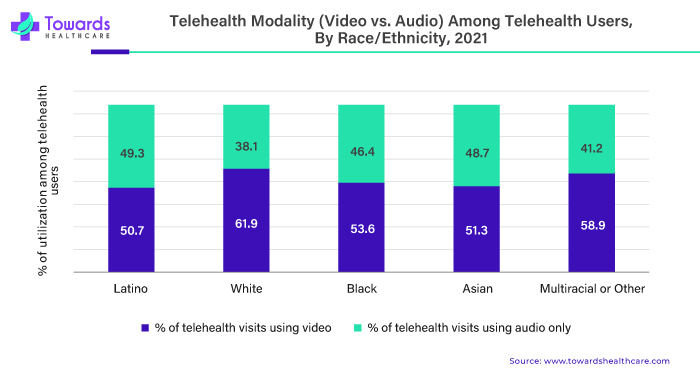
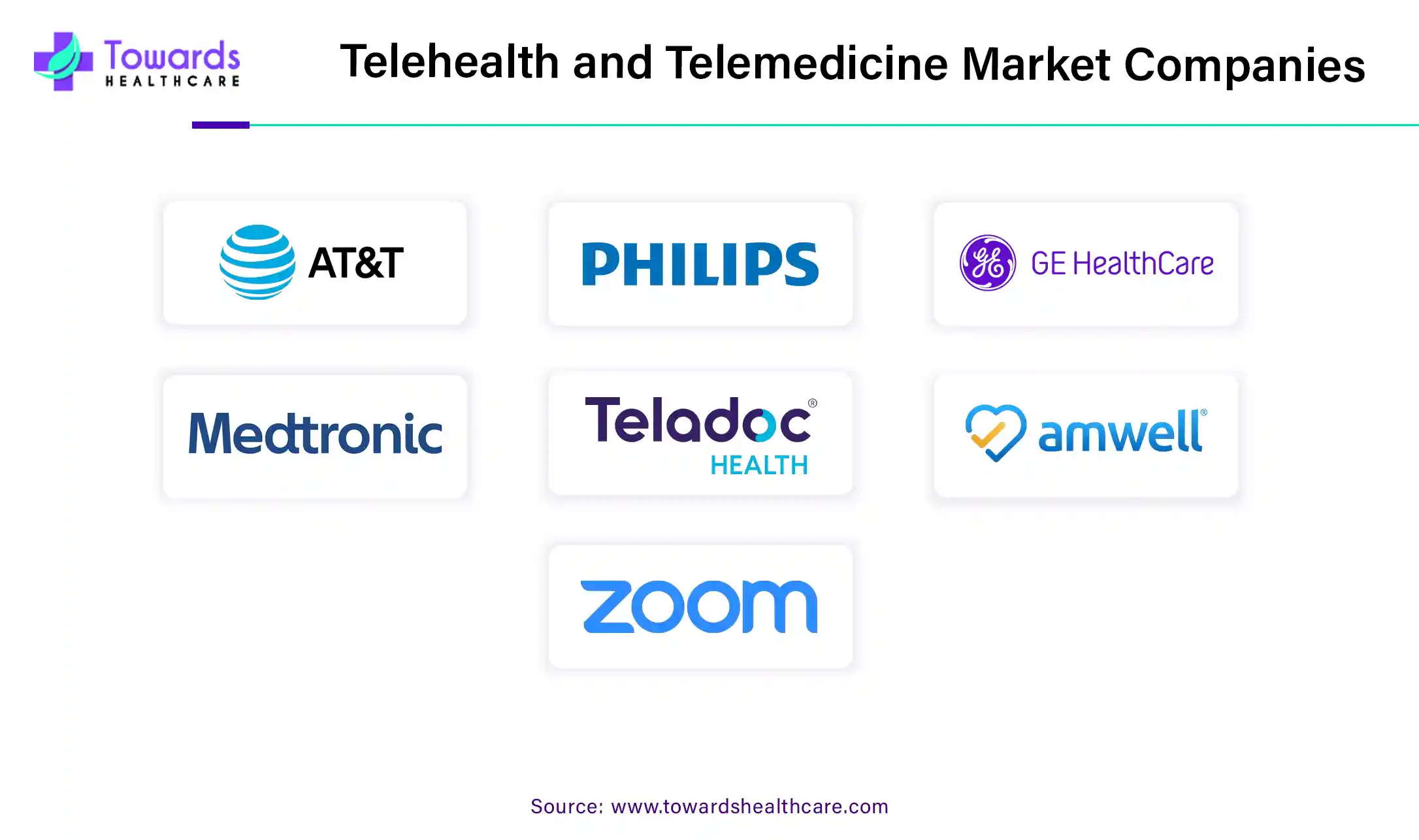
By Component
By Delivery Model
By Technology
By Application
By Geography
January 2026
January 2026
December 2025
December 2025